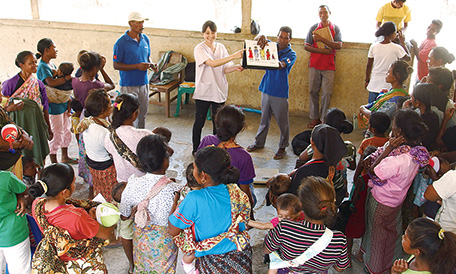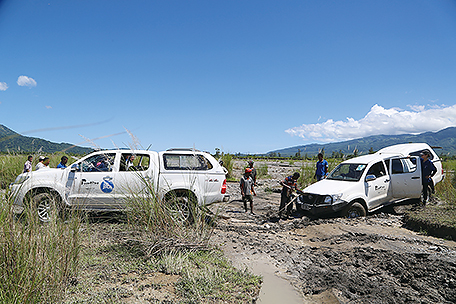Stories from the field 05
Medical Network for Medically Isolated Communities
– Medical Rounds and Training Assistance for Local Volunteers in Timor-Leste

Ms. Kikuchi together with health workers provides health guidance to residents of the Leimia Rai Ikun Village regarding dangerous postpartum symptoms at a traveling clinic in the village. (Photo: Celcio Menezes Da Silva, local staff member of NPO Frontline)
Timor-Leste gained independence in 2002, but the conflict that led to its independence resulted in a catastrophic impact on the health and medical system, and human resources in that field. The effects of this still remain today as there are countless communities in the country without access to medical care. As a result, Timor-Leste initiated Integrated Community Health Services (SISCa) in 2008. Under this service, physicians and nurses from sub-district health centers conduct medical rounds in villages without access to medical care, while community health workers, who are local volunteers, assist with disease detection and health management. However, there are still a number of communities that SISCa is not able to adequately provide for.
Given this situation, “Chikyu-no-Stage” (English name: Frontline), a Japanese NGO that has continually provided medical assistance to developing countries, initiated maternal and child health assistance in Timor-Leste in 2008. From January 2014, Frontline has launched a project called “Enhance Community Health Workers (CHW) Activities through SISCa in Hatolia Sub-District” as part of JICA Partnership Program (JPP)1 mechanism.
Ms. Yo Kikuchi of Frontline is working on the ground in Timor-Leste. Ms. Kikuchi developed an interest in remote medicine while studying at Jichi Medical University’s School of Nursing and was placed in a remote part of Indonesia as a Japan Overseas Cooperation Volunteer for maternal and child health care for a two-year period from 2011. After completing her term, Ms. Kikuchi participated in the activities of Frontline with the strong conviction of wanting to “save the lives of those who can be saved” in developing countries for the foreseeable future. Later she was dispatched to Timor-Leste.
Ms. Kikuchi investigated the implementation of SISCa together with local staff. She learned from villagers that “No one had come on medical rounds for a year and a half, and community health workers were doing nothing.”
The seven villages in the Hatolia sub-district, where Frontline conducts its activities, are each remotely located and difficult to access from any urban area. During the monsoon season, roads become impassable due to flooding on almost a daily basis. Despite this, Ms. Kikuchi traveled to all 34 communities in these seven villages in search of new community health workers.
Ms. Kikuchi established a system whereby physicians or nurses who visit these villages as part of SISCa’s monthly medical rounds instruct community health workers about specific patient care and treatment methods for tuberculosis, pregnancy, and infants suffering from malnutrition, among other health issues. These community health workers are then able to pass on what they learn to local community members. Ms. Kikuchi accompanies all medical rounds and observes the work being performed by community health workers in each village. She then instructs them individually on care and treatment methods using an approach tailored to the needs of each volunteer.
Through this training and instruction, the community’s health system, led by community health workers, has improved dramatically. The process has fostered community health workers who are now able to immediately detect and report changes in someone’s health to the sub-district health center. It has also developed a pool of human resources. Thanks to the knowledge they gained from training, community health workers have been able to save countless lives by detecting patients with a high risk of death and transporting them immediately to receive urgent care.
However, there was another issue, which was to change the mindset of medical staff at the local health center in the Hatolia sub-district. At the outset of the project, Ms. Kikuchi found out during her visits with local staff to the health center that most medical staff did not like going out on medical rounds.
Locally, the maternal mortality rate is 270 persons per 100,000 births (in Japan it is 6 persons per 100,000 births) and the newborn mortality rate is 24 deaths per 1,000 newborns (in Japan it is 1 death per 1,000 newborns). Ms. Kikuchi continued to engage medical staff in one-on-one conversations trying to convince them that medical rounds were essential to improve this situation. She says, “I needed to engage them in conversation several times for them to understand.”
These steady efforts began to change the mindset of medical staff and now (July 2015) at least three medical staff take part in each medical round.

On the way to Aslau Sare Village with a six-member medical team as a traveling clinic. Such trips are often plagued by happenings such as cars getting stuck in the mud, or damaged roads that need to be repaired. (Photo: Akiko Goto, Director-General of NPO Frontline)
The seven villages subject to medical rounds are each remotely located with poor access to other parts of the country. Frontline and the medical staff team head to communities where people are waiting for them, sometimes traversing locations with little in the way of roads. This has made it possible for people in these remote areas who never had access to medical care to receive regular medical visits.
The goal of the project is for community health workers to be able to work closely with the medical staff of the sub-district health center while continuing their activities in each community. However, according to Ms. Kikuchi, activities are currently around 20% of where she wants them to be. “We still have a long way to go. The best approach now is to visit each village together with medical staff and provide instruction,” says Ms. Kikuchi, who is excited for another day of training in the field.
*1 For more information, see Glossary.
<< Previous Page Next Page >>
Main Text | Statistics and Reference Materials | Stories from the field | Master Techniques, From Japan to the World | ODA Topics
